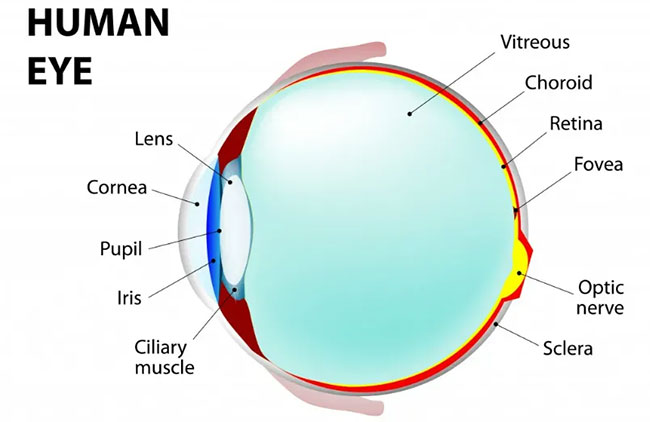What is special about fish eyes to make them see clearly underwater?
Have you ever dived underwater and tried opening your eyes to see everything below in blurry and out of focus images. You wonder if fish see things the same way, or if they have other specialized ways of seeing underwater. Not quite, to help us understand how fish eyes look, let's examine the subject through the 'prism' of anatomy, evolution and optics.
The eye has a very complex structure and function. The basic structure and function of the eye is more or less the same for all vertebrates. This structure took less than 100 million years to form. In the scope of this article, we will consider only three basic components — the lens, vitreous (the gel that holds at the back of the eye), and the fovea (the fovea). As light passes through the eye, it also passes through the vitreous - which is a water-like liquid, while the vitreous helps focus light on the fovea. The fovea is the part of the eye where sharp images are formed. In other words, it is the part that allows us to see clearly.

The complex structure of an eye.
Seeing underwater is very different from how we see it on land:
- First, water absorbs more light than air. This makes things darker as you move deeper into the water. In this thought test, we're only looking at visibility at a depth of 80 meters, since light doesn't travel below that point.
- Second, water 'absorbs' red light the most, followed by orange, yellow, green and then blue. This means that everything underwater will appear a little more "blue" in color. Things get even greener as you dive in.
However, that is not the only property of underwater light, let's continue to explore the properties that make everything underwater a bit dim.
To understand this, we will investigate two issues - the physics of light and the anatomy of the eye. To be more specific, we'll look at how light works underwater. Water is "dense" than air so light travels more slowly than underwater, although this small time difference is almost imperceptible, it has other effects as well.
A common term you may hear in optics is refraction. Refraction refers to the phenomenon of light changing direction when it passes through the interface between two transparent media with different refractive indices. An example is when light travels from air to water. This is why a pencil will look like it's broken or bent when you put it in water.

When light is focused at a certain point in the eye, it creates a sharp image.
When light travels from a "less dense" material medium to a denser medium, it will undergo convergence. When light is focused at a certain point in the eye, it creates a sharp image, which is done by the lens. The way the lens in the eye works is because light is focused. For the image to be clear, the light must be focused precisely at the fovea. If the light is not focused on the fovea, it will create a blurry image.
When underwater, light passing through the eye must be refracted enough to focus on the fovea. If light is not refracted enough, everything will look blurry, like farsightedness in the human eye. The chart below depicts farsightedness, you will better understand where light is focused when there is insufficient refraction.

Effects of visual impairment
When light enters the eye under water, it will not be refracted much. This is because the densities of the lens and water are very similar. At this time, the role of the lens in the eye will be promoted, the lens is denser, refracts more light. A lens with a rather round shape, which causes light to pass through it for a longer distance, refracting it more This causes the light to focus at the right point. If the lens were flatter, it would not focus properly, as described above.

Spherical lens in a fish's eye
Another reason is that the angle at which light passes through the glass is larger, this is due to the curved surface of the lens. According to the law of refraction, it will refract light better, more concentrated light This makes the light focus on the right point. If the lens were flatter, it would not focus properly, as described above.
Spherical lenses also have the ability to warp images, so fish observing their surroundings also tend to slightly warp towards images, but that's what gives them a wider field of view.
 Image depicts how from fisheye lens, everything looks more warped and warped, but you get a wider field of view
Image depicts how from fisheye lens, everything looks more warped and warped, but you get a wider field of view
Humans and other land animals have flat lenses because they help us focus in the air, while fish have more rounded lenses to help them focus in water, which is a great adaptation for fish. Sight in fish is highly evolved and complex, but in fact land animals have adapted more impressively. Fisheye and fisheye lenses, referred to as an "original blueprint".
- The fish has the most peculiar eyes in the world
- The most bizarre fish species on the planet
- Video: Fish kicks in the underwater championship
- Admire the 4 most special fish species in the world
- Wearing artificial fish helps people breathe underwater
- Underwater photography techniques make you squint
- Anableps - Anableps
- Discover strange 4-eye fish with 360-degree vision
- The incredible abilities of aquatic creatures
- Clarify the evolution of underwater animals to the surface
- Strange fish have eyes like us
- Found fish have strange eyes
 Animal 'suffering' after hibernation
Animal 'suffering' after hibernation Why do goats climb well?
Why do goats climb well? Scientists were surprised to see chimpanzees eating turtles
Scientists were surprised to see chimpanzees eating turtles Giant catfish died deadly due to drought in Thailand
Giant catfish died deadly due to drought in Thailand 9 billion light years away, 'space hole' facing Earthlings
9 billion light years away, 'space hole' facing Earthlings  Simulating Einstein's formula, scientists prove that light can create matter
Simulating Einstein's formula, scientists prove that light can create matter  How do animals see the world?
How do animals see the world?  How do real life invisibility cloaks work?
How do real life invisibility cloaks work?  Double quasars travel through 10 billion years to Earth, about to merge into a monster
Double quasars travel through 10 billion years to Earth, about to merge into a monster  What happens after humans travel faster than the speed of light?
What happens after humans travel faster than the speed of light? 